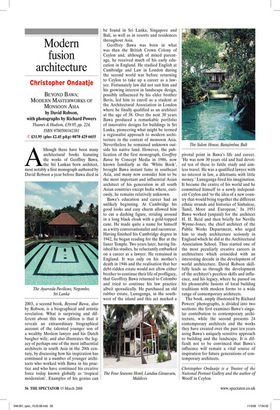Modern fusion architecture
Christopher Ondaatje
BEYOND BAWA: MODERN MASTERWORKS OF MONSOON ASIA by David Robson, with photographs by Richard Powers Thames & Hudson, £39.95, pp. 224, ISBN 9780500342381 ✆ £31.95 (plus £2.45 p&p) 0870 429 6655 Although there have been many architectural books featuring the works of Geoffrey Bawa, the Sri Lankan born architect, most notably a first monograph authored by David Robson a year before Bawa died in 2003, a second book, Beyond Bawa, also by Robson, is a biographical and artistic revelation. What is surprising and different about this new edition is that it reveals an extraordinary biographical account of the talented younger son of a wealthy Moslem lawyer and his Dutch burgher wife; and also illustrates the legacy of perhaps one of the most influential architects in south Asia in the 20th century, by discussing how his inspiration has continued in a number of younger architects who worked with Bawa in his practice and who have continued his creative force today known globally as ‘tropical modernism’. Examples of his genius can be found in Sri Lanka, Singapore and Bali, as well as in resorts and residences throughout Asia.
Geoffrey Bawa was born in what was then the British Crown Colony of Ceylon and, although of mixed parentage, he received much of his early education in England. He studied English at Cambridge and Law in London during the second world war before returning to Ceylon to take up a career as a lawyer. Fortunately law did not suit him and his growing interest in landscape design, possibly influenced by his elder brother Bevis, led him to enroll as a student at the Architectural Association in London where he finally qualified as an architect at the age of 38. Over the next 30 years Bawa produced a remarkable portfolio of innovative designs for buildings in Sri Lanka, pioneering what might be termed a regionalist approach to modern architecture in the context of monsoon Asia. Nevertheless he remained unknown outside his native land. However, the publication of the first monograph, Geoffrey Bawa by Concept Media in 1986, now known familiarly as the ‘White Book’, brought Bawa instant fame in southeast Asia, and many now consider him to be the most important and influential Asian architect of his generation in all south Asian countries except India where, curiously, he remains relatively unknown.
Bawa’s education and career had an unlikely beginning. At Cambridge his good looks and easy charm allowed him to cut a dashing figure, striding around in a long black cloak with a gold-topped cane. He made quite a name for himself as a witty conversationalist and raconteur. Having finished his Cambridge degree in 1942, he began reading for the Bar at the Inner Temple. Two years later, having finished his studies, he reluctantly embarked on a career as a lawyer. He remained in England. It was only on his mother’s death in 1946 and the realisation that her debt-ridden estate would not allow either brother to continue their life of profligacy, that Geoffrey Bawa returned to Colombo and tried to continue his law practice albeit sporadically. He purchased an old rubber estate, Lunuganga, in the southwest of the island and this act marked a pivotal point in Bawa’s life and career. ‘He was now 30 years old and had devoted ten of these to futile study and aimless travel. He was a qualified lawyer with no interest in law, a dilettante with little money.’ Lunuganga fired his imagination. It became the centre of his world and he committed himself to a newly independent Ceylon and ‘to the idea of a new country that would bring together the different ethnic strands and histories of Sinhalese, Tamil, Moor and European.’ In 1951 Bawa worked (unpaid) for the architect H. H. Reid and then briefly for Neville Wynne-Jones, the chief architect of the Public Works Department, who urged him to study architecture seriously in England which he did at the Architectural Association School. Thus started one of the most peculiarly creative careers in architecture which coincided with an interesting decade in the development of world architecture. David Robson skillfully leads us through the development of the architect’s peerless skills and influence, and his legacy, where he passed on his pleasurable fusions of local building traditions with modern forms to a wide range of contemporary architects.
The book, amply illustrated by Richard Powers’ photographs, is divided into two sections: the first examines Bawa’s singular contribution to contemporary architecture, while the second presents 24 contemporary architects and the works they have created over the past ten years using Bawa’s uniquely sensitive approach to building and the landscape. It is difficult not to be convinced that Bawa’s influence will remain a vital source of inspiration for future generations of contemporary architects.


























































































 Previous page
Previous page